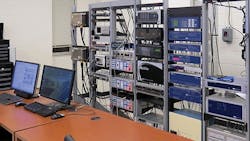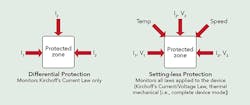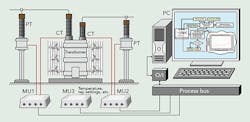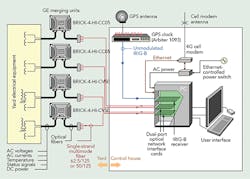NYPA Pilots Advanced Power System Protection
Since the early days of electric power systems, protection has been essential for the operation and safeguarding of power system assets as well as the safety of its users. Developed for the out-of-step protection of generating units, the first system protection concept was based on impedance relays. Subsequently, wide-area measurements were used for systemwide monitoring and protection. Special protection schemes typically use precomputed scenarios and arm the system when these scenarios materialize, and the relays respond accordingly. This approach can be classified as a pattern-recognition approach.
The introduction of GPS-synchronized measurements created more possibilities for better implementation of wide-area monitoring and protection. Yet, the approach remains the same and is limited by time latencies required to transfer the data to a central location, process the data and compare it to precomputed disturbance patterns.
While the installed protection systems work reasonably well today, the overall environment of protective relay setting has become complex:
• The new multifunction devices have a large number of configuration elements, settings and routine upgrades by firmware that require close scrutiny.
• There are new power electronic interfaces such as inverters that exhibit fault currents comparable to load currents.
• There is no substation-level view of protection; all coordination within the substation falls on the shoulders of the protection engineer.
• The ability to detect and locate some faults — such as faults near the neutral of transformers or faults to the soil (down conductors) — is difficult, leading to gaps in protection.
• Modeling errors play a major role in many protection failures, leading to wide-area blackouts.
• Asset management is complicated by the relatively short life of microprocessor relays compared to electromechanical relays and the frequent issuance of firmware upgrades by vendors.
This broad collection of issues more than warrants a fresh look at how to protect the grid.
First Phase
In 2011, the Electric Power Research Institute (EPRI) initiated a project called Grid Transformation that identified four core research areas:
• Seamless geospatial power system model
• Seamless power system analytics
• Integrated energy management system
• Setting-less protection method.
The setting-less protection effort was funded by EPRI under a grant to the Georgia Institute of Technology (Georgia Tech). The first phase assessed existing protection methods and prior work on state-estimation-based protection.
The project team began developing approaches and methods for setting-less protection and determining the ability of existing technology to support the requirements. Additionally, the team formulated and developed algorithms for setting-less protection for specific zone-protection problems: generator/unit protection, line protection, transformer protection and capacitor bank protection. Lastly, the team determined the feasibility of the setting-less protection method and tested its performance in the laboratory using hardware and a simulator to generate and feed various fault events into the hardware. This first phase proved promising and work continued.
Setting-less Protection Approach
In principle, the approach is a generalization of differential protection. Differential protection monitors the satisfaction of Kirchoff’s Current Law, which says the sum of the currents going into a node or protection zone must equal zero. Setting-less protection extends the monitoring to all physical laws (Kirchoff’s Current/Voltage Law, thermodynamic laws and so forth) that must be obeyed by the protection zone. These laws are expressed in the dynamic model equations of the protection zone.
This is done systematically through a dynamic state estimation that continuously monitors how well the data fits the dynamic model of the protection zone. This also can be described as measuring or monitoring as many quantities as possible, and using dynamic state estimation to monitor continuously the operating state (condition, health) of the protection zone (component). The state estimation enables the identification of bad data, model changes or other anomalies, and can issue diagnostics or alarms accordingly.
The setting-less protective relay acts on the basis of the protection zone operating condition. There are two basic advantages with this approach:
• There is no need to know what is happening in the rest of the system. This means no coordination is needed with any other protective devices.
• The dynamic state estimation operates every time a new set of sampled values arrive and identifies immediately what is happening in the protection zone. Faults and other abnormal conditions are identified within two or three sampling periods, much faster than traditional relaying that requires phasors to exercise the logic, which results in time delays of at least one or two cycles.
Second Phase
The main objective for the second phase of the setting-less protection research effort was to develop a prototype setting-less protective relay and demonstrate it in the laboratory. The laboratory implementation closely represented field conditions. Specifically, the hardware consisted mainly of commercially available devices interfaced with the setting-less protection relay.
The laboratory demonstration presented many challenges:
• Performing the dynamic state estimation computations in 0.1 msec
• Obtaining commercially available merging units capable of providing data to more than one device
• Obtaining highly accurate synchronized measurements
• Validating the technology over a realistic set of events.
Each of these challenges was overcome during the course of the research.
The laboratory experiments indicated the analytics of the setting-less protection function can be performed within the time period between two successive sets of streaming data. This means the setting-less protection can operate in real time as any other numerical relay by simply using a standard high-end processor. For complex protection zones, either higher-power computers may be needed or the algorithms could be parallelized, running on multiple core computers.
Laboratory demonstrations indicated this technology can form the basis for centralized substation protection schemes. It is still necessary to develop the actual architecture for a centralized substation protection system that will have substantial advantages over current approaches. For example, the results of the setting-less protection relays can be used in a substation-wide dynamic state estimator capable of detecting hidden failures, bad data and such.
The setting-less protection method is being evaluated in a field demonstration to assess its advantages and disadvantages, gauge feasibility and identify potential transition issues from a single protective device-based protection scheme.
NYPA Demonstration Project
In 2013, the New York State Energy Research and Development Authority issued a program opportunity notice under the Electric Power Transmission and Distribution Smart Grid Program. Georgia Tech submitted a proposal with New York Power Authority (NYPA), EPRI and GE for the demonstration of setting-less protection on the NYPA system. The project will implement and evaluate the setting-less protective relay on two proposed protection zones of the NYPA system: the 765-/345-/13.8-kV autobanks at Marcy substation, and the 765-kV transmission line between Marcy and Massena substations.
The setting-less protective relay system will be implemented using merging units, streaming the data to a process bus. A PC will retrieve the data from the process bus and perform the setting-less protection function.
The proposed project will demonstrate a new approach for power system protection that does not require coordination with other protection schemes in the system and, therefore, removes the complexities of present-day protection schemes; and that increases protection security and reliability.
The ultimate benefit to the electric power system will be increased overall reliability and security of the system, but the technology also has the potential to reduce the cost of protection drastically as well as reduce relay misoperations.
The setting-less relay will not be connected to the control circuits of the breakers, but it will include a historian to store operational data from the relay over long periods of time. The project team estimates all the data used by the setting-less relay can be stored in the relay computer for a period of at least three months. The data will be retrieved every two months and archived, making it available for further research and analysis. It also is important to mention one of the measurements will be the current in the neutral of the autobank. This current measurement will be able to provide the direct current through the neutral if direct current is occurring (for example, for geomagnetically induced current events).
Final Thoughts
In the long run, the setting-less protection technology can provide major advantages over traditional coordinated protection. The technology provides a holistic approach to protection that considers the overall operation of the equipment in the protection zone, rather than just specific performance features. Therefore, it can evaluate the equipment state using multiple types of data from various, diverse sources of information, thus capturing the correlations among different types of phenomena that can point to a specific problem. This can result in more accurate protection decisions and actions, and can significantly eliminate potential protection misoperations.
The fact the proposed scheme does not segregate but combines the various physical aspects of the same piece of equipment (electrical, mechanical and thermal) results in one unified protection scheme, rather than multiple separated schemes, each one looking at a narrow range of phenomena. In turn, this results in a less complex overall scheme, as no coordination between the various protection systems is required. This can eliminate effort in setting up the protection scheme as well as maintaining it and performing changes to it when modifications are made to the physical system.
Bruce Fardanesh ([email protected]) is the chief electrical engineer of the New York Power Authority. He manages a staff of close to 100 professionals working in the areas of power systems operations planning, transmission planning, protection and control engineering, electrical equipment engineering and metering. Fardanesh holds a BSEE degree from Sharif University of Technology in Tehran, Iran, a MSEE degree from the University of Missouri-Rolla and a Ph.D. degree from Cleveland State University. Fardanesh is an IEEE Fellow and serves on the EPRI Research Advisory Committee.
Paul Myrda ([email protected]) is a technical executive with EPRI and manages the information communications technology transmission program and Grid Transformation project. Myrda represents EPRI on advisory boards for the Trustworthy Cyber Infrastructure for the Power Grid Center and North American Synchrophasor Initiative. He holds an MBA degree from Kellogg, and MSEE and BSEE degrees from the Illinois Institute of Technology. He is a licensed professional engineer and a member of IEEE and CIGRE.
A.P. Sakis Meliopoulos ([email protected]) is a Georgia Power Distinguished Professor at the Georgia Institute of Technology and is active in teaching and research in the general areas of modeling, analysis, protection and control of power systems. Meliopoulos is chairman of the Georgia Tech Protective Relaying Conference and an IEEE Fellow. He holds ME and EE diplomas from the National Technical University of Athens, Greece, and MSEE and Ph.D. degrees from the Georgia Institute of Technology.
Mentioned in this article:
EPRI | www.epri.com
GE | www.ge.com
New York Power Authority | www.nypa.gov
NYSERDA | www.nyserda.ny.gov
Sidebar: Early Component Protection
Protective relaying was developed to protect individual components. As networks grew, system problems and system protection issues arose. In recent decades, new system protection approaches have developed.
Initially, electromechanical relays were introduced at the early stages of the power industry. Electromechanical relays are devices designed to perform a logic function based on specific inputs of voltages and/or currents that operate mechanical components to perform a function, usually to close or open a contact. This technology started with the simple plunger-type relay and evolved into highly sophisticated systems that performed complex logical operations.
In the early years of the electric power industry, the inverse time-delay overcurrent relay was developed based on the induction disk (Westinghouse) or the induction cup (GE). The overcurrent protection function is one of the main protection functions provided in practically all protection schemes. Over the years, the electromechanical relays developed into sophisticated analog logic devices with great selectivity and operational reliability. The development of differential protection and distance protection were two major milestones.
The introduction of the transistor in the late 1940s resulted in solid-state devices that can perform logic operations. The 1960s brought about efforts to develop solid-state relays with the same functionality as the electromechanical relays. Solid-state relays were short lived as the first effort to develop digital (numerical relays) was in the late 1960s. The first digital relay developed in 1970 formulated the approach for digital relays. These efforts were refined when the microprocessor was introduced in the early 1980s and led to the development of the microprocessor-based relay (numerical relay).
The first commercially available numerical relay appeared in the early 1980s, as Westinghouse and GE developed prototypes under EPRI funding for an all-digital transmission substation, and Schweitzer introduced the first microprocessor relay for distribution system applications in 1984. Since then, penetration of the numerical relay has increased to the point where today it has almost displaced electromechanical and solid-state relays completely. By and large, numerical relays simply mimic the logic developed for the electromechanical relays but in a more flexible manner. Because numerical relays can pack many protection functions in one box, numerical relays are multifunctional. The increased functionality has resulted in very complex schemes that, many times, lead to inconsistencies and the possibility of improper protection actions.





